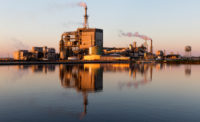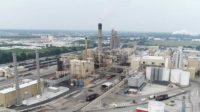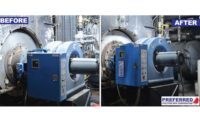Replacing old steam systems can improve efficiency, cut costs, and reduce emissions. A Houston-based petrochemical producer replaced nine aging boilers with two units from Rentech Boilers using Coen ultra-low-NOx burners. The new boilers drive 38-MW GE turbogenerators and power compressors and also provide process heat. Once installed, the facility noted a jump in efficiency, lowered running costs, and reduced NOx emissions.
The original boilers were more than 50 years old. The plant could reduce the number of boilers needed due to the implementation of the latest technology as well as the fact that steam requirements dropped from 1.5 million pounds per hour to between 850,000 and 1.2 million.
The main components of the boilers were built and assembled at the manufacturer’s site. Each boiler had two sections prefabricated and were shipped to Houston to be assembled on-site. The D-style, field-erected watertube boilers had a heat input of 664 MMBtu/h and could produce 474,000 pounds per hour steam flow at 725 psig and 710°F superheat. Each came with dual burners, a superheater, an economizer, a fan, ladders, platforms, stack, and trim.
The volumetric heat release rate for these units is below 60,000 Btuh per cubic foot, which is critical in achieving ultra-low-NOx conditions. Continuous high-frequency, resistance-welded, finned tubes are used to boost convection section efficiency. Longitudinal, vertical baffles are included to eliminate problematic acoustic vibration. Dedicated, unheated downcomers ensure circulation, make more efficient use of the steam drum, and stabilize the drum level during rapid changes. The steam drum is conservatively sized for the steam flow and provides steam quality of no more than 0.05% moisture carryover.
The single-stage superheater is a separate module that was hydrostatically tested prior to its installation in the boiler. It is located behind the division wall and screen tubes to protect it from direct radiation. This provides a fairly flat steam temperature from 50%-100% load. Steam temperature is guaranteed at 100% maximum continuous rating (MCR) to be 710° +/-15°. Membrane wall construction along the outboard side of the convection section reduces the occurrence of casing leaks.
Coen Delta NOx ULN burners make the boilers capable of rapid ramp up to meet a facility’s needs. These burners operate with high flue gas recirculation (FGR) rates to attain ultra-low-NOx levels.
Strong winds coming in from the Gulf of Mexico presented a challenge during installation and commissioning. These winds caused flame outs, poor combustion, and coking of the burner elements. The solution was to modify the fresh and core air inlets. Instead of the usual 45-degree angle, incoming air now makes a 180-degree turn to eliminate any wind gust effect.
In addition, improved control logic for both boilers linearizes the fuel flow and airflow to the boiler master for all fuel compositions. For a given heat input, the combustion airflow and fuel flow can be different depending on the actual fuel composition. As the composition of the plant gas varies, the new logic solves any problems that could be potentially caused by variability.
The boilers are also easer to operate since operators make minimal changes to bias on air dampers or O2 bias to control NOx. Previously, operators adjusted bias several times per hour to control NOx emissions. Following installation and commissioning, the plant reports an efficiency increase of 7% compared to the older boilers. Lower emissions have translated into reduced operating costs.





